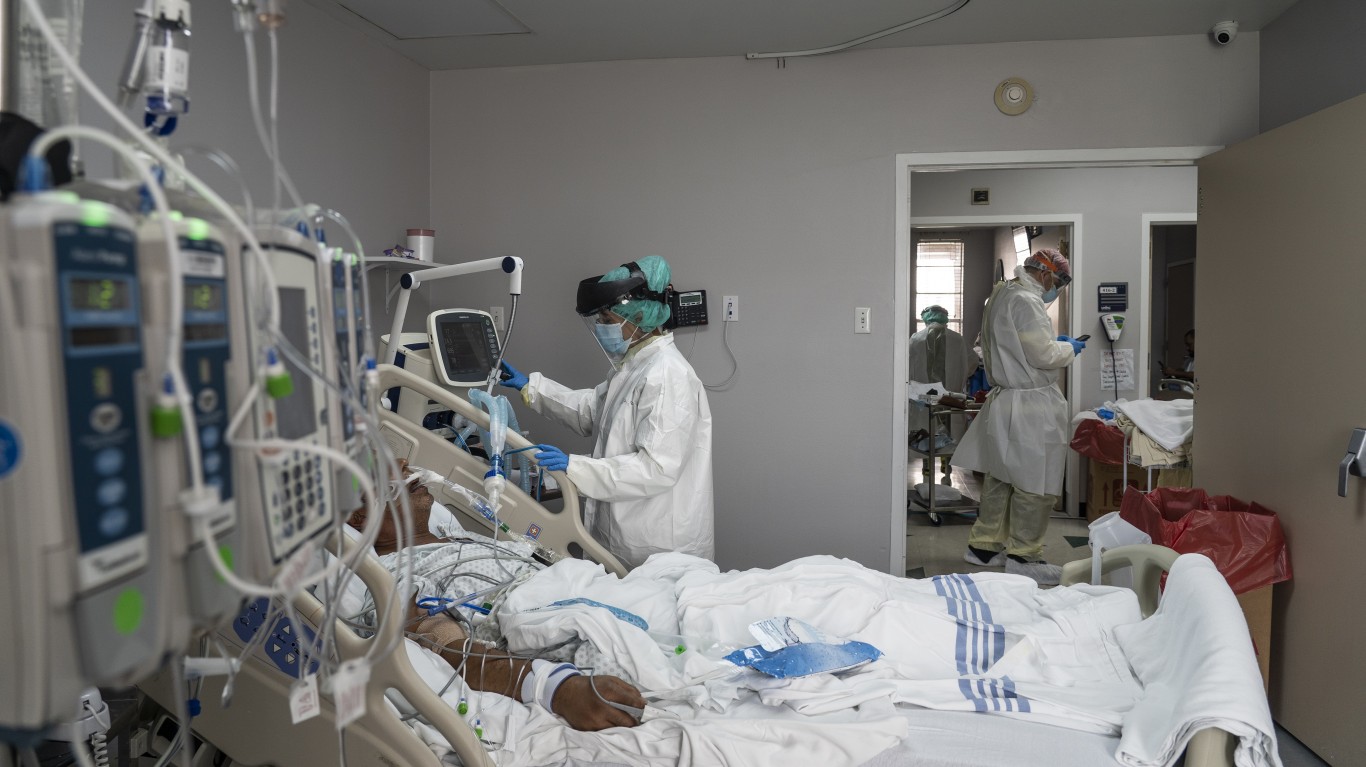Special Report
This is the City in Every State Where COVID-19 is Growing the Fastest

Published:

The U.S. has reported more than 31.8 million confirmed COVID-19 cases as of Apr. 29. There have been more than 567,000 reported deaths from COVID-19-related causes — the highest death toll of any country.
The extent of the spread of the novel coronavirus continues to vary considerably from state to state, and from city to city. Even as the number of daily new cases is flattening or even declining in some parts of the country, it is surging at a growing rate in others.
Nationwide, the number of new cases is growing at a steady rate. There were an average of 16.6 daily new coronavirus cases per 100,000 Americans in the week ending Apr. 29, essentially unchanged from the week prior, when there were an average of 20.4 daily new coronavirus cases per 100,000 people.
Metropolitan areas with a high degree of mobility and a large population may be particularly vulnerable to outbreaks. While science and medical professionals are still studying how exactly the virus spreads, experts agree that outbreaks are more likely to occur in group settings where large numbers of people routinely have close contact with one another. Cities with high concentrations of dense spaces such as colleges, correctional facilities, and nursing homes are particularly at risk.
The city with the highest seven-day average of new daily COVID-19 cases per capita is in Michigan. In the Muskegon, MI, metro area, there were an average of 69.2 daily new coronavirus cases per 100,000 residents in the week ending Apr. 29, the most of any U.S. metro area. Other cities where COVID-19 is growing the fastest include Flint, MI; Saginaw, MI; and Bay City, MI.
To determine the metropolitan area in each state where COVID-19 is growing the fastest, 24/7 Wall St. compiled and reviewed data from state and local health departments. We ranked metropolitan areas according to the average number of new daily COVID-19 cases per 100,000 residents in the seven days ending Apr. 29. Data was aggregated from the county level to the metropolitan area level using boundary definitions from the U.S. Census Bureau. Population data used to adjust case and death totals came from the U.S. Census Bureau’s 2019 American Community Survey and are five-year estimates. Unemployment data is from the Bureau of Labor Statistics and is seasonally adjusted.

Alabama: Mobile
Avg. new daily cases in Mobile in week ending Apr. 29: 41.4 per 100,000
Avg. new daily cases in Mobile in week ending Apr. 22: 45.1 per 100,000
COVID-19 cases in Mobile as of Apr. 29: 42,307 (9,823.9 per 100,000)
Peak pandemic unemployment in Mobile: 15.4% (April 2020)
Mobile population: 430,655 (186.5 people per sq. mi.)

Alaska: Fairbanks
Avg. new daily cases in Fairbanks in week ending Apr. 29: 39.0 per 100,000
Avg. new daily cases in Fairbanks in week ending Apr. 22: 18.7 per 100,000
COVID-19 cases in Fairbanks as of Apr. 29: 7,484 (7,554.1 per 100,000)
Peak pandemic unemployment in Fairbanks: 11.4% (April 2020)
Fairbanks population: 99,072 (13.5 people per sq. mi.)
These are all the counties in Alaska where COVID-19 is slowing (and where it’s still getting worse).

Arizona: Flagstaff
Avg. new daily cases in Flagstaff in week ending Apr. 29: 14.5 per 100,000
Avg. new daily cases in Flagstaff in week ending Apr. 22: 16.5 per 100,000
COVID-19 cases in Flagstaff as of Apr. 29: 17,677 (12,512.6 per 100,000)
Peak pandemic unemployment in Flagstaff: 17.9% (April 2020)
Flagstaff population: 141,274 (7.6 people per sq. mi.)

Arkansas: Jonesboro
Avg. new daily cases in Jonesboro in week ending Apr. 29: 7.8 per 100,000
Avg. new daily cases in Jonesboro in week ending Apr. 22: 9.7 per 100,000
COVID-19 cases in Jonesboro as of Apr. 29: 16,456 (12,538.8 per 100,000)
Peak pandemic unemployment in Jonesboro: 9.3% (April 2020)
Jonesboro population: 131,241 (89.5 people per sq. mi.)

California: Santa Cruz-Watsonville
Avg. new daily cases in Santa Cruz in week ending Apr. 29: 13.4 per 100,000
Avg. new daily cases in Santa Cruz in week ending Apr. 22: 10.3 per 100,000
COVID-19 cases in Santa Cruz as of Apr. 29: 15,929 (5,814.3 per 100,000)
Peak pandemic unemployment in Santa Cruz: 16.4% (April 2020)
Santa Cruz population: 273,962 (615.4 people per sq. mi.)

Colorado: Pueblo
Avg. new daily cases in Pueblo in week ending Apr. 29: 39.4 per 100,000
Avg. new daily cases in Pueblo in week ending Apr. 22: 37.3 per 100,000
COVID-19 cases in Pueblo as of Apr. 29: 17,475 (10,528.3 per 100,000)
Peak pandemic unemployment in Pueblo: 11.8% (April 2020)
Pueblo population: 165,982 (69.6 people per sq. mi.)

Connecticut: New Haven-Milford
Avg. new daily cases in New Haven in week ending Apr. 29: 28.2 per 100,000
Avg. new daily cases in New Haven in week ending Apr. 22: 36.4 per 100,000
COVID-19 cases in New Haven as of Apr. 29: 88,949 (10,372.9 per 100,000)
Peak pandemic unemployment in New Haven: 9.5% (July 2020)
New Haven population: 857,513 (1,418.5 people per sq. mi.)

Delaware: Dover
Avg. new daily cases in Dover in week ending Apr. 29: 28.6 per 100,000
Avg. new daily cases in Dover in week ending Apr. 22: 38.5 per 100,000
COVID-19 cases in Dover as of Apr. 29: 17,137 (9,698.4 per 100,000)
Peak pandemic unemployment in Dover: 17.3% (May 2020)
Dover population: 176,699 (301.4 people per sq. mi.)

Florida: Miami-Fort Lauderdale-Pompano Beach
Avg. new daily cases in Miami in week ending Apr. 29: 36.1 per 100,000
Avg. new daily cases in Miami in week ending Apr. 22: 42.3 per 100,000
COVID-19 cases in Miami as of Apr. 29: 856,779 (14,067.1 per 100,000)
Peak pandemic unemployment in Miami: 13.8% (April 2020)
Miami population: 6,090,660 (1,199.6 people per sq. mi.)

Georgia: Atlanta-Sandy Springs-Alpharetta
Avg. new daily cases in Atlanta in week ending Apr. 29: 13.8 per 100,000
Avg. new daily cases in Atlanta in week ending Apr. 22: 16.8 per 100,000
COVID-19 cases in Atlanta as of Apr. 29: 589,025 (10,047.5 per 100,000)
Peak pandemic unemployment in Atlanta: 12.8% (April 2020)
Atlanta population: 5,862,424 (674.9 people per sq. mi.)

Hawaii: Kahului-Wailuku-Lahaina
Avg. new daily cases in Kahului in week ending Apr. 29: 9.3 per 100,000
Avg. new daily cases in Kahului in week ending Apr. 22: 14.6 per 100,000
COVID-19 cases in Kahului as of Apr. 29: 4,241 (2,555.1 per 100,000)
Peak pandemic unemployment in Kahului: 34.8% (April 2020)
Kahului population: 165,979 (142.9 people per sq. mi.)
These are all the counties in Hawaii where COVID-19 is slowing (and where it’s still getting worse).

Idaho: Boise City
Avg. new daily cases in Boise City in week ending Apr. 29: 13.4 per 100,000
Avg. new daily cases in Boise City in week ending Apr. 22: 15.7 per 100,000
COVID-19 cases in Boise City as of Apr. 29: 80,900 (11,382.5 per 100,000)
Peak pandemic unemployment in Boise City: 12.6% (April 2020)
Boise City population: 710,743 (60.4 people per sq. mi.)
These are all the counties in Idaho where COVID-19 is slowing (and where it’s still getting worse).

Illinois: Peoria
Avg. new daily cases in Peoria in week ending Apr. 29: 46.4 per 100,000
Avg. new daily cases in Peoria in week ending Apr. 22: 68.0 per 100,000
COVID-19 cases in Peoria as of Apr. 29: 48,365 (11,886.7 per 100,000)
Peak pandemic unemployment in Peoria: 18.9% (April 2020)
Peoria population: 406,883 (122.0 people per sq. mi.)

Indiana: Michigan City-La Porte
Avg. new daily cases in Michigan City in week ending Apr. 29: 39.4 per 100,000
Avg. new daily cases in Michigan City in week ending Apr. 22: 51.8 per 100,000
COVID-19 cases in Michigan City as of Apr. 29: 11,411 (10,359.1 per 100,000)
Peak pandemic unemployment in Michigan City: 21.6% (April 2020)
Michigan City population: 110,154 (184.1 people per sq. mi.)

Iowa: Davenport-Moline-Rock Island, IA-IL
Avg. new daily cases in Davenport in week ending Apr. 29: 21.8 per 100,000
Avg. new daily cases in Davenport in week ending Apr. 22: 26.7 per 100,000
COVID-19 cases in Davenport as of Apr. 29: 40,164 (10,536.9 per 100,000)
Peak pandemic unemployment in Davenport: 16.0% (April 2020)
Davenport population: 381,175 (167.9 people per sq. mi.)
These are all the counties in Iowa where COVID-19 is slowing (and where it’s still getting worse).

Kansas: Lawrence
Avg. new daily cases in Lawrence in week ending Apr. 29: 10.0 per 100,000
Avg. new daily cases in Lawrence in week ending Apr. 22: 7.4 per 100,000
COVID-19 cases in Lawrence as of Apr. 29: 9,181 (7,632.4 per 100,000)
Peak pandemic unemployment in Lawrence: 12.1% (April 2020)
Lawrence population: 120,290 (263.9 people per sq. mi.)
These are all the counties in Kansas where COVID-19 is slowing (and where it’s still getting worse).

Kentucky: Bowling Green
Avg. new daily cases in Bowling Green in week ending Apr. 29: 14.0 per 100,000
Avg. new daily cases in Bowling Green in week ending Apr. 22: 17.7 per 100,000
COVID-19 cases in Bowling Green as of Apr. 29: 20,100 (11,518.8 per 100,000)
Peak pandemic unemployment in Bowling Green: 18.8% (April 2020)
Bowling Green population: 174,498 (108.1 people per sq. mi.)

Louisiana: Lake Charles
Avg. new daily cases in Lake Charles in week ending Apr. 29: 15.4 per 100,000
Avg. new daily cases in Lake Charles in week ending Apr. 22: 21.1 per 100,000
COVID-19 cases in Lake Charles as of Apr. 29: 22,858 (10,960.5 per 100,000)
Peak pandemic unemployment in Lake Charles: 14.9% (April 2020)
Lake Charles population: 208,549 (88.8 people per sq. mi.)

Maine: Lewiston-Auburn
Avg. new daily cases in Lewiston in week ending Apr. 29: 62.9 per 100,000
Avg. new daily cases in Lewiston in week ending Apr. 22: 72.8 per 100,000
COVID-19 cases in Lewiston as of Apr. 29: 7,077 (6,577.0 per 100,000)
Peak pandemic unemployment in Lewiston: 10.3% (July 2020)
Lewiston population: 107,602 (230.0 people per sq. mi.)
These are all the counties in Maine where COVID-19 is slowing (and where it’s still getting worse).

Maryland: Hagerstown-Martinsburg, MD-WV
Avg. new daily cases in Hagerstown in week ending Apr. 29: 23.8 per 100,000
Avg. new daily cases in Hagerstown in week ending Apr. 22: 29.6 per 100,000
COVID-19 cases in Hagerstown as of Apr. 29: 27,090 (9,567.5 per 100,000)
Peak pandemic unemployment in Hagerstown: 12.0% (April 2020)
Hagerstown population: 283,147 (280.9 people per sq. mi.)

Massachusetts: Springfield
Avg. new daily cases in Springfield in week ending Apr. 29: 23.3 per 100,000
Avg. new daily cases in Springfield in week ending Apr. 22: 29.5 per 100,000
COVID-19 cases in Springfield as of Apr. 29: 61,533 (8,797.0 per 100,000)
Peak pandemic unemployment in Springfield: 17.1% (June 2020)
Springfield population: 699,480 (379.4 people per sq. mi.)

Michigan: Muskegon
Avg. new daily cases in Muskegon in week ending Apr. 29: 69.2 per 100,000
Avg. new daily cases in Muskegon in week ending Apr. 22: 59.8 per 100,000
COVID-19 cases in Muskegon as of Apr. 29: 14,035 (8,098.8 per 100,000)
Peak pandemic unemployment in Muskegon: 29.8% (April 2020)
Muskegon population: 173,297 (347.1 people per sq. mi.)

Minnesota: St. Cloud
Avg. new daily cases in St. Cloud in week ending Apr. 29: 38.1 per 100,000
Avg. new daily cases in St. Cloud in week ending Apr. 22: 42.5 per 100,000
COVID-19 cases in St. Cloud as of Apr. 29: 27,013 (13,603.0 per 100,000)
Peak pandemic unemployment in St. Cloud: 9.4% (May 2020)
St. Cloud population: 198,581 (113.4 people per sq. mi.)

Mississippi: Hattiesburg
Avg. new daily cases in Hattiesburg in week ending Apr. 29: 7.0 per 100,000
Avg. new daily cases in Hattiesburg in week ending Apr. 22: 6.4 per 100,000
COVID-19 cases in Hattiesburg as of Apr. 29: 17,600 (10,465.2 per 100,000)
Peak pandemic unemployment in Hattiesburg: 13.3% (April 2020)
Hattiesburg population: 168,177 (83.1 people per sq. mi.)

Missouri: St. Louis, MO-IL
Avg. new daily cases in St. Louis in week ending Apr. 29: 8.9 per 100,000
Avg. new daily cases in St. Louis in week ending Apr. 22: 12.9 per 100,000
COVID-19 cases in St. Louis as of Apr. 29: 282,591 (10,073.9 per 100,000)
Peak pandemic unemployment in St. Louis: 11.6% (April 2020)
St. Louis population: 2,805,190 (356.7 people per sq. mi.)

Montana: Great Falls
Avg. new daily cases in Great Falls in week ending Apr. 29: 9.0 per 100,000
Avg. new daily cases in Great Falls in week ending Apr. 22: 19.5 per 100,000
COVID-19 cases in Great Falls as of Apr. 29: 8,798 (10,778.6 per 100,000)
Peak pandemic unemployment in Great Falls: 12.6% (April 2020)
Great Falls population: 81,625 (30.3 people per sq. mi.)

Nebraska: Omaha-Council Bluffs, NE-IA
Avg. new daily cases in Omaha in week ending Apr. 29: 18.0 per 100,000
Avg. new daily cases in Omaha in week ending Apr. 22: 23.1 per 100,000
COVID-19 cases in Omaha as of Apr. 29: 114,317 (12,268.7 per 100,000)
Peak pandemic unemployment in Omaha: 10.2% (April 2020)
Omaha population: 931,779 (214.2 people per sq. mi.)

Nevada: Carson City
Avg. new daily cases in Carson City in week ending Apr. 29: 13.8 per 100,000
Avg. new daily cases in Carson City in week ending Apr. 22: 17.6 per 100,000
COVID-19 cases in Carson City as of Apr. 29: 6,406 (11,695.5 per 100,000)
Peak pandemic unemployment in Carson City: 21.0% (April 2020)
Carson City population: 54,773 (378.6 people per sq. mi.)
These are all the counties in Nevada where COVID-19 is slowing (and where it’s still getting worse).

New Hampshire: Manchester-Nashua
Avg. new daily cases in Manchester in week ending Apr. 29: 23.2 per 100,000
Avg. new daily cases in Manchester in week ending Apr. 22: 30.3 per 100,000
COVID-19 cases in Manchester as of Apr. 29: 34,540 (8,362.5 per 100,000)
Peak pandemic unemployment in Manchester: 17.5% (April 2020)
Manchester population: 413,035 (471.4 people per sq. mi.)

New Jersey: Atlantic City-Hammonton
Avg. new daily cases in Atlantic City in week ending Apr. 29: 29.2 per 100,000
Avg. new daily cases in Atlantic City in week ending Apr. 22: 43.1 per 100,000
COVID-19 cases in Atlantic City as of Apr. 29: 30,884 (11,605.9 per 100,000)
Peak pandemic unemployment in Atlantic City: 35.2% (June 2020)
Atlantic City population: 266,105 (478.9 people per sq. mi.)

New Mexico: Farmington
Avg. new daily cases in Farmington in week ending Apr. 29: 22.2 per 100,000
Avg. new daily cases in Farmington in week ending Apr. 22: 18.5 per 100,000
COVID-19 cases in Farmington as of Apr. 29: 14,400 (11,382.0 per 100,000)
Peak pandemic unemployment in Farmington: 14.5% (July 2020)
Farmington population: 126,515 (22.9 people per sq. mi.)

New York: Buffalo-Cheektowaga
Avg. new daily cases in Buffalo in week ending Apr. 29: 36.4 per 100,000
Avg. new daily cases in Buffalo in week ending Apr. 22: 51.9 per 100,000
COVID-19 cases in Buffalo as of Apr. 29: 104,184 (9,218.4 per 100,000)
Peak pandemic unemployment in Buffalo: 19.5% (April 2020)
Buffalo population: 1,130,175 (722.1 people per sq. mi.)

North Carolina: Rocky Mount
Avg. new daily cases in Rocky Mount in week ending Apr. 29: 27.0 per 100,000
Avg. new daily cases in Rocky Mount in week ending Apr. 22: 28.1 per 100,000
COVID-19 cases in Rocky Mount as of Apr. 29: 16,667 (11,363.0 per 100,000)
Peak pandemic unemployment in Rocky Mount: 14.2% (May 2020)
Rocky Mount population: 146,678 (140.3 people per sq. mi.)

North Dakota: Fargo, ND-MN
Avg. new daily cases in Fargo in week ending Apr. 29: 22.0 per 100,000
Avg. new daily cases in Fargo in week ending Apr. 22: 31.7 per 100,000
COVID-19 cases in Fargo as of Apr. 29: 32,103 (13,352.8 per 100,000)
Peak pandemic unemployment in Fargo: 7.7% (April 2020)
Fargo population: 240,421 (85.5 people per sq. mi.)

Ohio: Toledo
Avg. new daily cases in Toledo in week ending Apr. 29: 21.6 per 100,000
Avg. new daily cases in Toledo in week ending Apr. 22: 29.2 per 100,000
COVID-19 cases in Toledo as of Apr. 29: 61,818 (9,597.0 per 100,000)
Peak pandemic unemployment in Toledo: 22.1% (April 2020)
Toledo population: 644,137 (398.0 people per sq. mi.)
These are all the counties in Ohio where COVID-19 is slowing (and where it’s still getting worse).

Oklahoma: Lawton
Avg. new daily cases in Lawton in week ending Apr. 29: 11.4 per 100,000
Avg. new daily cases in Lawton in week ending Apr. 22: 28.3 per 100,000
COVID-19 cases in Lawton as of Apr. 29: 14,285 (11,193.4 per 100,000)
Peak pandemic unemployment in Lawton: 19.5% (April 2020)
Lawton population: 127,620 (75.0 people per sq. mi.)

Oregon: Bend
Avg. new daily cases in Bend in week ending Apr. 29: 35.3 per 100,000
Avg. new daily cases in Bend in week ending Apr. 22: 28.9 per 100,000
COVID-19 cases in Bend as of Apr. 29: 7,756 (4,164.3 per 100,000)
Peak pandemic unemployment in Bend: 18.3% (April 2020)
Bend population: 186,251 (61.7 people per sq. mi.)
These are all the counties in Oregon where COVID-19 is slowing (and where it’s still getting worse).

Pennsylvania: East Stroudsburg
Avg. new daily cases in East Stroudsburg in week ending Apr. 29: 43.3 per 100,000
Avg. new daily cases in East Stroudsburg in week ending Apr. 22: 51.0 per 100,000
COVID-19 cases in East Stroudsburg as of Apr. 29: 13,667 (8,133.6 per 100,000)
Peak pandemic unemployment in East Stroudsburg: 20.5% (April 2020)
East Stroudsburg population: 168,032 (276.2 people per sq. mi.)

Rhode Island: Providence-Warwick, RI-MA
Avg. new daily cases in Providence in week ending Apr. 29: 34.6 per 100,000
Avg. new daily cases in Providence in week ending Apr. 22: 32.4 per 100,000
COVID-19 cases in Providence as of Apr. 29: 197,369 (12,196.3 per 100,000)
Peak pandemic unemployment in Providence: 18.5% (April 2020)
Providence population: 1,618,268 (1,019.8 people per sq. mi.)

South Carolina: Greenville-Anderson
Avg. new daily cases in Greenville in week ending Apr. 29: 18.8 per 100,000
Avg. new daily cases in Greenville in week ending Apr. 22: 22.3 per 100,000
COVID-19 cases in Greenville as of Apr. 29: 121,295 (13,538.3 per 100,000)
Peak pandemic unemployment in Greenville: 12.5% (April 2020)
Greenville population: 895,942 (330.5 people per sq. mi.)

South Dakota: Sioux Falls
Avg. new daily cases in Sioux Falls in week ending Apr. 29: 19.8 per 100,000
Avg. new daily cases in Sioux Falls in week ending Apr. 22: 29.1 per 100,000
COVID-19 cases in Sioux Falls as of Apr. 29: 41,781 (16,110.0 per 100,000)
Peak pandemic unemployment in Sioux Falls: 10.7% (April 2020)
Sioux Falls population: 259,348 (100.7 people per sq. mi.)

Tennessee: Clarksville, TN-KY
Avg. new daily cases in Clarksville in week ending Apr. 29: 34.9 per 100,000
Avg. new daily cases in Clarksville in week ending Apr. 22: 26.6 per 100,000
COVID-19 cases in Clarksville as of Apr. 29: 29,391 (9,814.3 per 100,000)
Peak pandemic unemployment in Clarksville: 16.6% (April 2020)
Clarksville population: 299,470 (138.8 people per sq. mi.)

Texas: San Antonio-New Braunfels
Avg. new daily cases in San Antonio in week ending Apr. 29: 20.1 per 100,000
Avg. new daily cases in San Antonio in week ending Apr. 22: 18.5 per 100,000
COVID-19 cases in San Antonio as of Apr. 29: 260,853 (10,568.6 per 100,000)
Peak pandemic unemployment in San Antonio: 13.8% (April 2020)
San Antonio population: 2,468,193 (337.5 people per sq. mi.)
These are all the counties in Texas where COVID-19 is slowing (and where it’s still getting worse).

Utah: Provo-Orem
Avg. new daily cases in Provo in week ending Apr. 29: 12.6 per 100,000
Avg. new daily cases in Provo in week ending Apr. 22: 12.5 per 100,000
COVID-19 cases in Provo as of Apr. 29: 96,263 (15,607.1 per 100,000)
Peak pandemic unemployment in Provo: 8.1% (April 2020)
Provo population: 616,791 (114.3 people per sq. mi.)
These are all the counties in Utah where COVID-19 is slowing (and where it’s still getting worse).

Vermont: Burlington-South Burlington
Avg. new daily cases in Burlington in week ending Apr. 29: 12.5 per 100,000
Avg. new daily cases in Burlington in week ending Apr. 22: 21.6 per 100,000
COVID-19 cases in Burlington as of Apr. 29: 9,357 (4,276.8 per 100,000)
Peak pandemic unemployment in Burlington: 14.8% (April 2020)
Burlington population: 218,784 (174.7 people per sq. mi.)

Virginia: Winchester, VA-WV
Avg. new daily cases in Winchester in week ending Apr. 29: 19.2 per 100,000
Avg. new daily cases in Winchester in week ending Apr. 22: 23.9 per 100,000
COVID-19 cases in Winchester as of Apr. 29: 12,324 (8,955.0 per 100,000)
Peak pandemic unemployment in Winchester: 10.5% (April 2020)
Winchester population: 137,621 (129.5 people per sq. mi.)

Washington: Longview
Avg. new daily cases in Longview in week ending Apr. 29: 24.4 per 100,000
Avg. new daily cases in Longview in week ending Apr. 22: 27.0 per 100,000
COVID-19 cases in Longview as of Apr. 29: 5,587 (5,232.4 per 100,000)
Peak pandemic unemployment in Longview: 16.5% (April 2020)
Longview population: 106,778 (93.7 people per sq. mi.)

West Virginia: Beckley
Avg. new daily cases in Beckley in week ending Apr. 29: 37.7 per 100,000
Avg. new daily cases in Beckley in week ending Apr. 22: 35.7 per 100,000
COVID-19 cases in Beckley as of Apr. 29: 9,773 (8,224.5 per 100,000)
Peak pandemic unemployment in Beckley: 18.4% (April 2020)
Beckley population: 118,828 (93.8 people per sq. mi.)

Wisconsin: Janesville-Beloit
Avg. new daily cases in Janesville in week ending Apr. 29: 22.4 per 100,000
Avg. new daily cases in Janesville in week ending Apr. 22: 23.9 per 100,000
COVID-19 cases in Janesville as of Apr. 29: 17,454 (10,764.0 per 100,000)
Peak pandemic unemployment in Janesville: 16.3% (April 2020)
Janesville population: 162,152 (225.8 people per sq. mi.)

Wyoming: Cheyenne
Avg. new daily cases in Cheyenne in week ending Apr. 29: 15.5 per 100,000
Avg. new daily cases in Cheyenne in week ending Apr. 22: 11.6 per 100,000
COVID-19 cases in Cheyenne as of Apr. 29: 8,993 (9,146.7 per 100,000)
Peak pandemic unemployment in Cheyenne: 9.2% (April 2020)
Cheyenne population: 98,320 (36.6 people per sq. mi.)
Click here to see all coronavirus data for every state.
Credit card companies are pulling out all the stops, with the issuers are offering insane travel rewards and perks.
We’re talking huge sign-up bonuses, points on every purchase, and benefits like lounge access, travel credits, and free hotel nights. For travelers, these rewards can add up to thousands of dollars in flights, upgrades, and luxury experiences every year.
It’s like getting paid to travel — and it’s available to qualified borrowers who know where to look.
We’ve rounded up some of the best travel credit cards on the market. Click here to see the list. Don’t miss these offers — they won’t be this good forever.
Thank you for reading! Have some feedback for us?
Contact the 24/7 Wall St. editorial team.